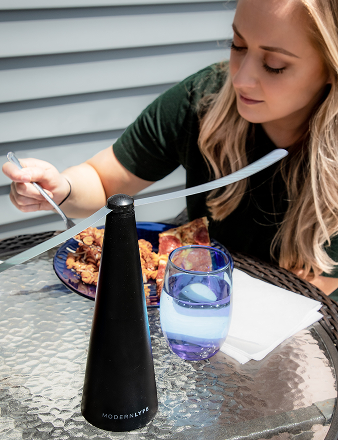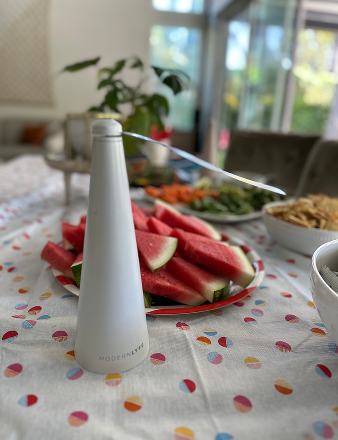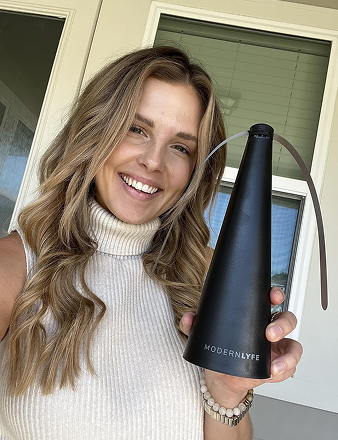Searching for the best outdoor fan for mosquitoes comes down to one thing: airflow. You need a high CFM (Cubic Feet per Minute) rating to physically blow these weak-flying pests away. A powerful, well-placed fan creates a protective breeze that’s too strong for mosquitoes to penetrate, giving you a chemical-free way to enjoy your patio.
Your Chemical-Free Solution for a Mosquito-Free Patio
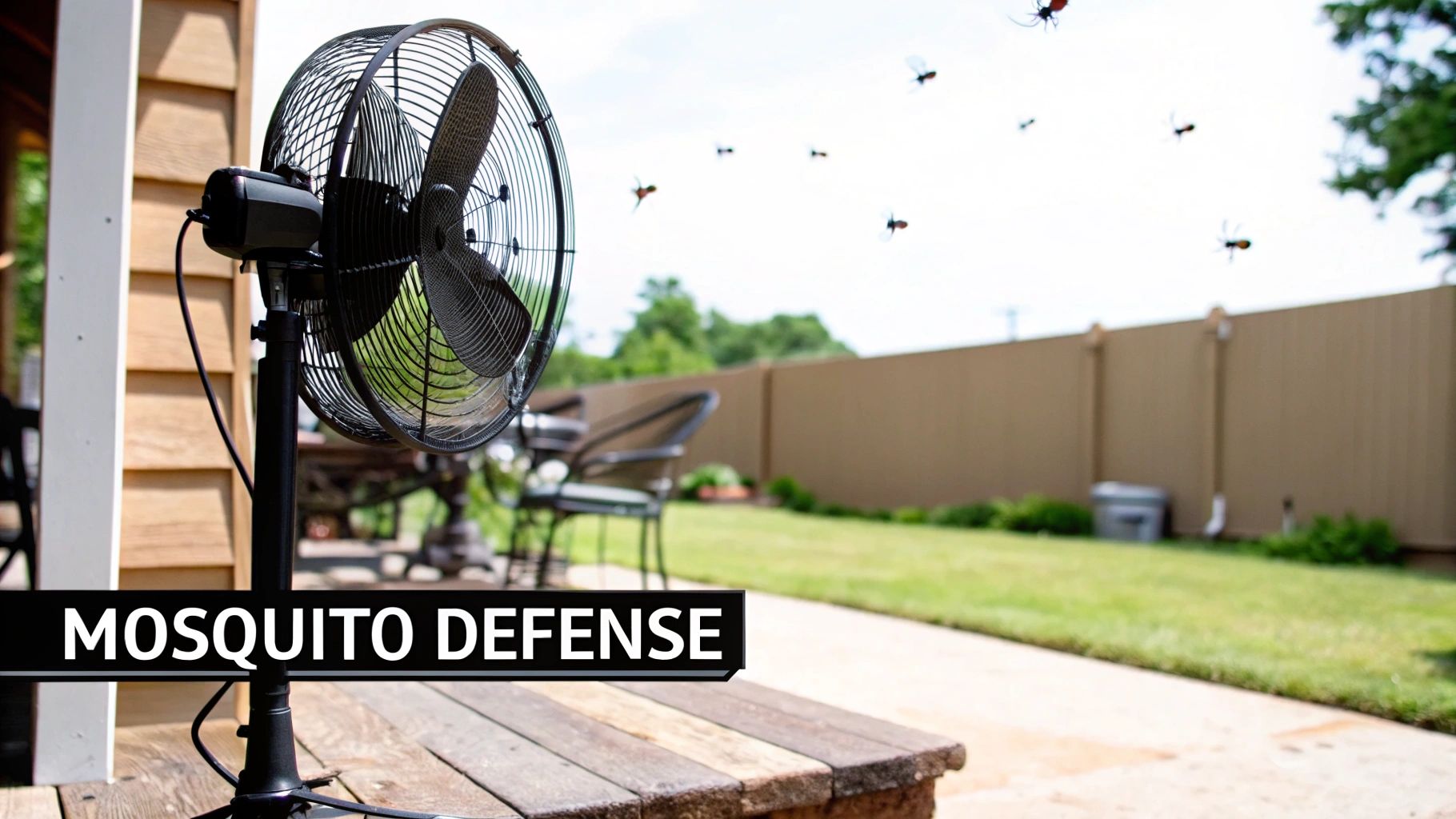
Tired of sticky sprays and the constant zap of a bug zapper? You’re not alone. Taking back your outdoor space shouldn’t require harsh chemicals. Often, the simplest solution is the best: a strong, steady breeze.
An outdoor fan is your most powerful ally against biting insects. It works on a simple principle: mosquitoes are weak fliers and struggle against even a moderate wind. A good fan generates an invisible wall of moving air they physically cannot cross.
Why Fans Are a Better Solution
Unlike bug zappers that attract more insects to your yard with light, a fan actively pushes them away. It also disperses the carbon dioxide (CO2) you exhale—the main signal mosquitoes use to find you. By scattering your CO2, you become practically invisible to them. It's a simple one-two punch.
People are catching on. The mosquito control market is booming, with the mosquito killer machine market valued at USD 755.7 million in 2025 and projected to hit USD 1,107.9 million by 2035. This growth shows a clear demand for effective, user-friendly solutions like fans.
Think of a fan's breeze as a gentle, invisible force field. It does more than cool you down; it creates a protective, bug-free bubble that makes your outdoor space comfortable and bite-free without sprays or odors.
This approach beats traditional methods. You can learn more about how to enjoy your outdoors with off-bug fans in our detailed guide.
Here's a quick breakdown of why a fan is a great choice.
Quick Guide to Using Fans for Mosquito Control
| Benefit | Why It Matters |
|---|---|
| Chemical-Free | Creates a safe environment for kids, pets, and guests without toxic sprays. |
| Highly Effective | The breeze physically stops weak-flying mosquitoes from ever reaching you. |
| Dual Purpose | Keeps you cool on hot days while providing bug protection. |
| Eco-Friendly | Unlike bug zappers, fans don't harm beneficial insects like bees and butterflies. |
A fan offers a practical, pleasant, and effective way to keep your outdoor gatherings focused on fun, not swatting.
How a Simple Breeze Makes You Invisible to Mosquitoes
Ever wonder how an outdoor fan works so well against mosquitoes? It’s not magic—it’s science that uses a mosquito's weaknesses against it. A steady, powerful breeze creates a protective barrier in two key ways, turning your patio into a no-fly zone.
The first line of defense is pure physics. Mosquitoes are terrible fliers. They're clumsy and lightweight, with delicate wings that can't handle a breeze. They struggle to fly at speeds over 1.5 mph.
Imagine trying to fly a tiny paper airplane on a windy day. That's what a mosquito faces against a quality fan. The wind is simply too strong, making it impossible to navigate, land, or bite.
Disrupting Their Flight Path
This physical pushback is incredibly effective. When you set up a fan, you create a localized weather system these pests can't handle. They have to burn too much energy just to stay airborne, let alone hunt. The fan's current grounds them before they get near you.
While knocking them out of the sky is great, the fan's real superpower is messing with a mosquito's senses. It turns you into a ghost, making you almost undetectable.
"If you are able to plug something in and you want to reduce mosquitoes biting on your deck or in your backyard... I’d just buy a big ass fan and blow the air over my guests and myself." - Laurence Zwiebel, PhD, Professor of Biological Science, Vanderbilt University
This expert take highlights the simple genius of using airflow as your main defense.
Making Your Scent Trail Vanish
Mosquitoes don’t hunt with their eyes; they hunt with smell. Their best tool is the ability to track the carbon dioxide (CO2) you exhale from up to 100 feet away. Your breath leaves a CO2 plume in the air—a breadcrumb trail leading them right to you.
This is where a fan becomes a strategic weapon. The constant airflow grabs the CO2 as you breathe out and scatters it instantly.
Instead of a concentrated trail, your scent gets diluted and mixed into the air, scrambling their internal GPS. Mosquitoes might detect CO2 nearby, but they can't pinpoint its source. You've vanished. While this is great for mosquitoes, some of the same ideas apply to houseflies, which you can learn more about in our guide on how fly fans work.
This one-two punch—physically overpowering them and chemically hiding you—is why a fan is one of the most effective tools for a bite-free summer.
Key Fan Features for Winning the War on Bugs
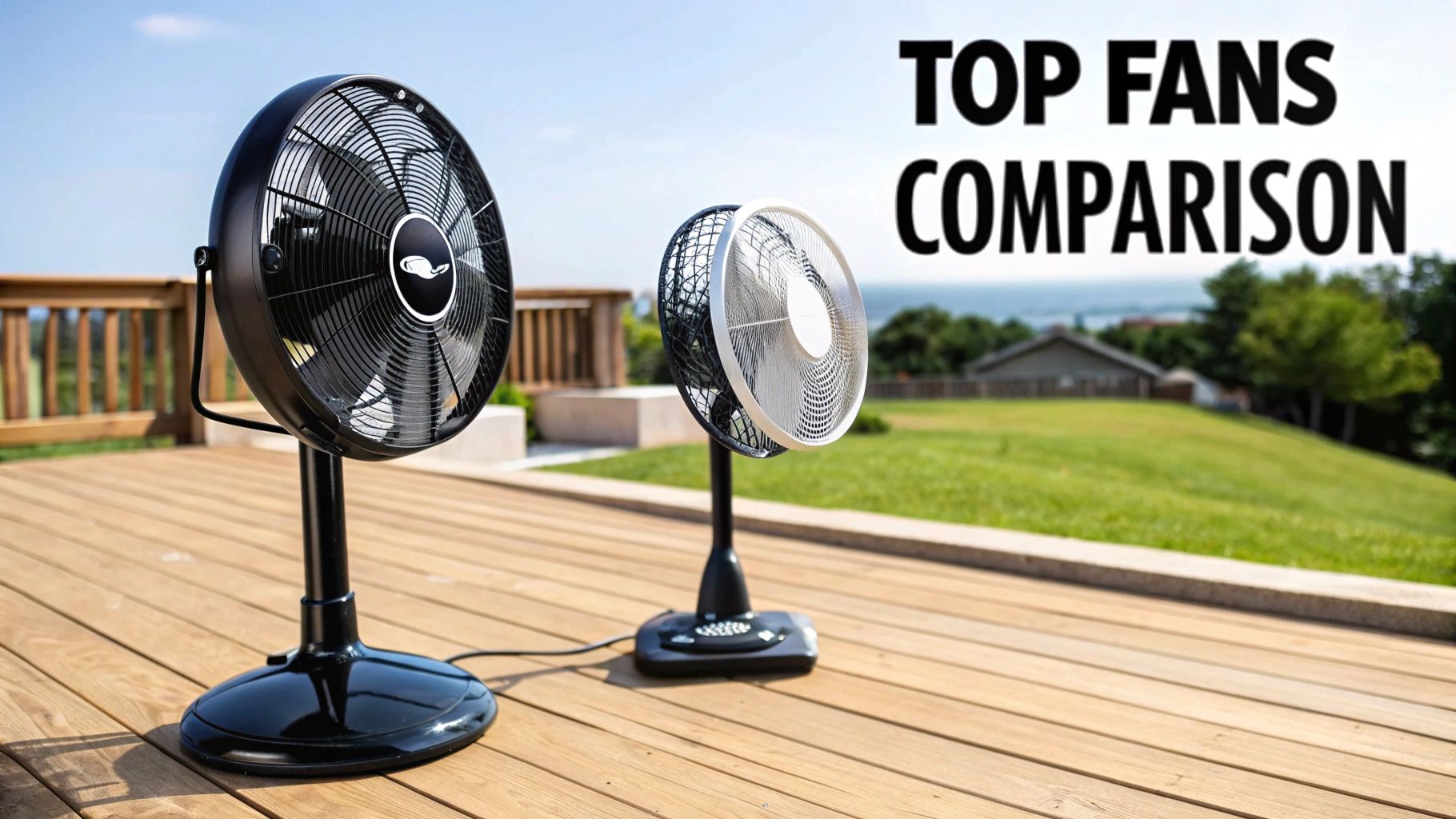
Not all outdoor fans are created equal. A few key specs transform a fan into a mosquito-repelling powerhouse. Focus on CFM, durability ratings, speed presets, and noise output to make shopping simple.
Understanding CFM And Coverage
Think of CFM (Cubic Feet per Minute) as the strength of your mosquito barrier. A higher CFM means a stronger, farther-reaching breeze.
Here’s a quick sizing guide:
- Small patio (up to 100 sq ft): 1,000 CFM keeps the air moving.
- Medium patio (100–200 sq ft): 2,000 CFM prevents dead zones.
- Large patio (over 200 sq ft): 3,000+ CFM blankets every corner.
A 2,000 CFM pedestal fan on a medium deck can cut mosquito landings by 85%, turning itchy evenings into relaxed nights.
Assessing UL Wet Ratings
Outdoor gear must withstand sun, wind, and rain. UL ratings are your insurance against rust, motor failure, and downtime.
- UL Wet Rating: Safe in direct rain.
- UL Damp Rating: Ideal for covered porches, but keep it out of direct rain.
- No Rating: Strictly for indoor use.
“Rain or shine, aim for a wet-rated fan to safeguard your investment and keep the breeze flowing.”
Choosing the right rating extends the fan’s lifespan and saves you from surprise repairs.
Balancing Speed Settings And Noise Levels
Dialing in the perfect airflow is key. You need quiet on low, balanced on medium, and full power on high. Modern designs often include noise-reduction tech so you can still hold a conversation.
- Low speed: Soft hum, gentle circulation.
- Mid speed: Solid air barrier, easy to talk over.
- High speed: Maximum CFM, ultimate mosquito defense.
38% of new models now run below 45 dB, making them quiet additions to your patio. Thanks to smarter designs, servicing time has dropped by 11%, and 22% of customers subscribe to replacement-part plans for peace of mind. Discover more insights on fan trends at Future Market Insights.
| Speed Setting | Approx CFM | Noise Level |
|---|---|---|
| Low | 800 | 35–40 dB |
| Medium | 2,000 | 40–45 dB |
| High | 3,500 | 50–55 dB |
A unit with at least three speeds lets you pick the right vibe without creating a windstorm.
Picking Power Options And Maintenance
How you power your fan dictates where it goes. Corded models offer endless runtime but tether you to an outlet. Battery and solar units bring freedom but have limited runtimes.
- Corded: Constant power, heavier build, fixed spot.
- Battery: Cordless mobility, limited hours, easy to reposition.
- Solar-assisted: Green energy, sun-dependent, often hybrid.
Routine upkeep—wiping dust off blades and checking mounts—extends performance. With the right power choice and a little care, your fan becomes a silent guardian against mosquitoes.
Choosing the Right Fan Type for Your Outdoor Space
Picking the perfect fan isn't just about staying cool—it’s about creating a powerful, mosquito-free zone. The best fan matches your layout, from seating arrangements to the size of the space. Consider portability, mounting options, and extra features like a cooling mist.
Each fan style offers something different. A pedestal fan gives you the freedom to move the breeze where you need it, while a wall-mounted fan saves floor space and provides consistent coverage.
Misting fans are great for dry, sweltering days, combining a bug-busting wind with a refreshing spray. For smaller seating areas, a simple floor fan creates a targeted, low-to-the-ground barrier that keeps ankle-biters away.
Which Outdoor Fan Style Is Right for You?
So, how do you decide? It comes down to how you use your space. This comparison breaks down the most common fan types to help you find your match.
| Fan Type | Best For | Pros | Cons |
|---|---|---|---|
| Pedestal | Flexible seating arrangements | Easy to move, adjustable height, powerful airflow | Takes up floor space, can be a trip hazard |
| Wall-Mounted | Covered porches or permanent setups | Saves floor space, provides consistent airflow | Not portable, requires installation |
| Misting | Hot, dry climates | Adds extra cooling, deters mosquitoes with wind & moisture | Can make humid areas feel damp, needs refilling |
| Floor | Small, intimate seating areas | Creates a low-angle wind barrier, compact | Limited coverage area |
A pedestal fan is your go-to if you're always rearranging chairs. But if you have a dedicated seating area and want clear walkways, a wall-mounted unit is a cleaner, permanent solution.
- Choose a pedestal fan if you value portability and need to direct the breeze on the fly.
- Go wall-mounted to free up your deck and deliver a steady, reliable wind.
- Opt for a misting fan when the heat is dry and intense for cooling and bug defense.
- Pick a floor fan for cozy nooks or to place between two chairs for targeted protection.
Getting this choice right sets you up for success.
“Matching fan type to setting multiplies its mosquito-blocking power,” notes backyard entertaining expert Jenna Cruz.
Visualizing Fan Performance
It’s one thing to talk about airflow, but seeing it in action helps. This graphic shows how effective a strong breeze is against a mosquito's flimsy wings. It’s simple physics: they can’t fight the wind.
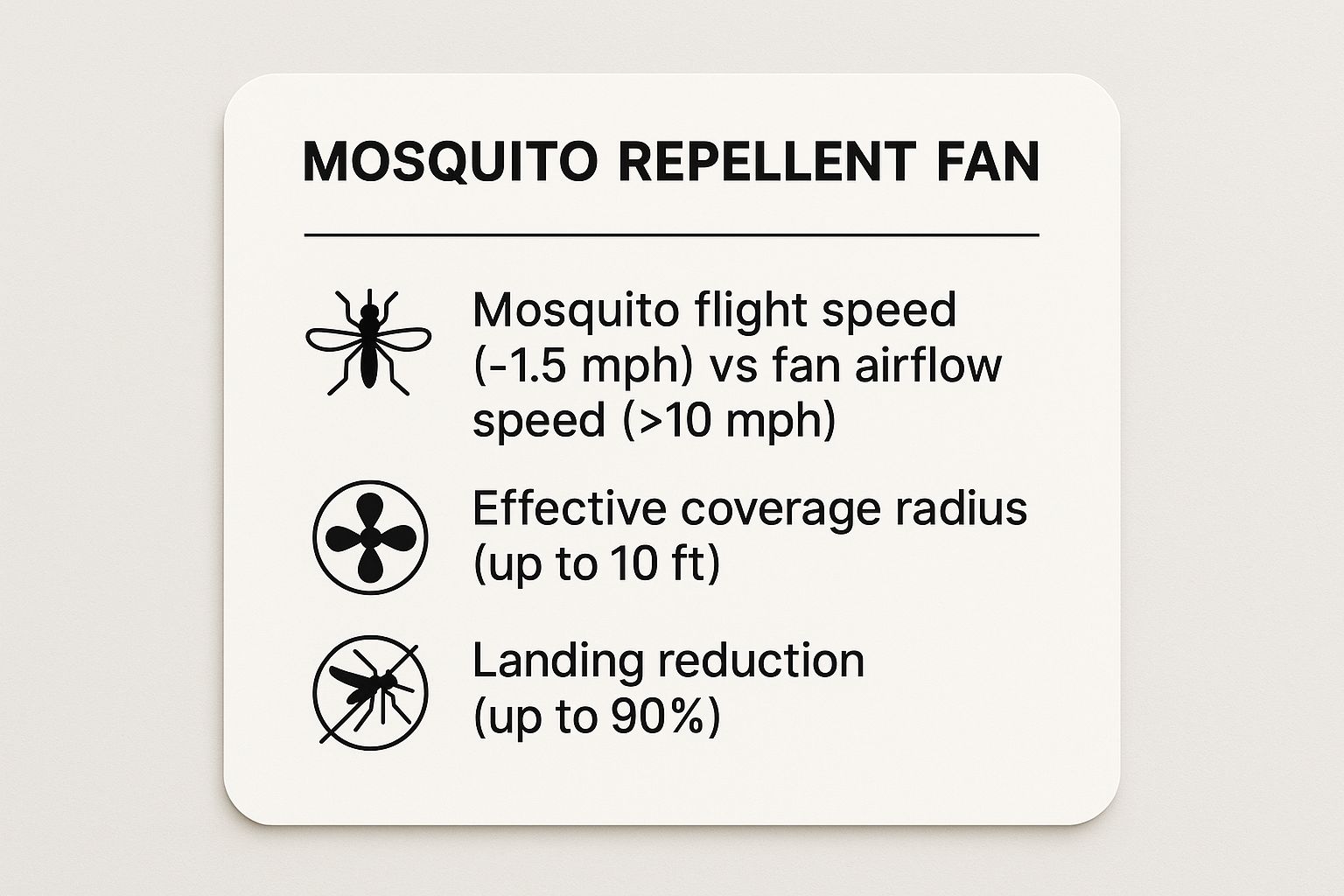
As you can see, an airflow over 10 mph can protect a 10 ft radius and cut mosquito landings by up to 90%. That’s a huge impact from something as simple as a fan.
While fans are a simple mechanical solution, the high-tech mosquito zapper market was valued at USD 450 million in 2024. It’s projected to hit USD 700 million by 2033, growing at a 5.5% annual rate. Dive deeper into these trends at Verified Market Reports.
Advanced Features for Mosquito Defense
Beyond the basics, many modern fans come with extra features to make your space even more comfortable. Ultra-quiet motors are perfect for peaceful evenings, while energy-efficient designs can run for hours on a battery or solar power, freeing you from extension cords.
For a layered defense, combine a powerful fan with other repellents. Our article on outdoor fly repellers explores how pairing different technologies can expand your pest-free zone.
By choosing a fan that fits your space and your needs, you can turn your backyard into a cool, comfortable sanctuary where mosquitoes aren’t invited.
How to Create a Mosquito-Free Zone with Smart Placement
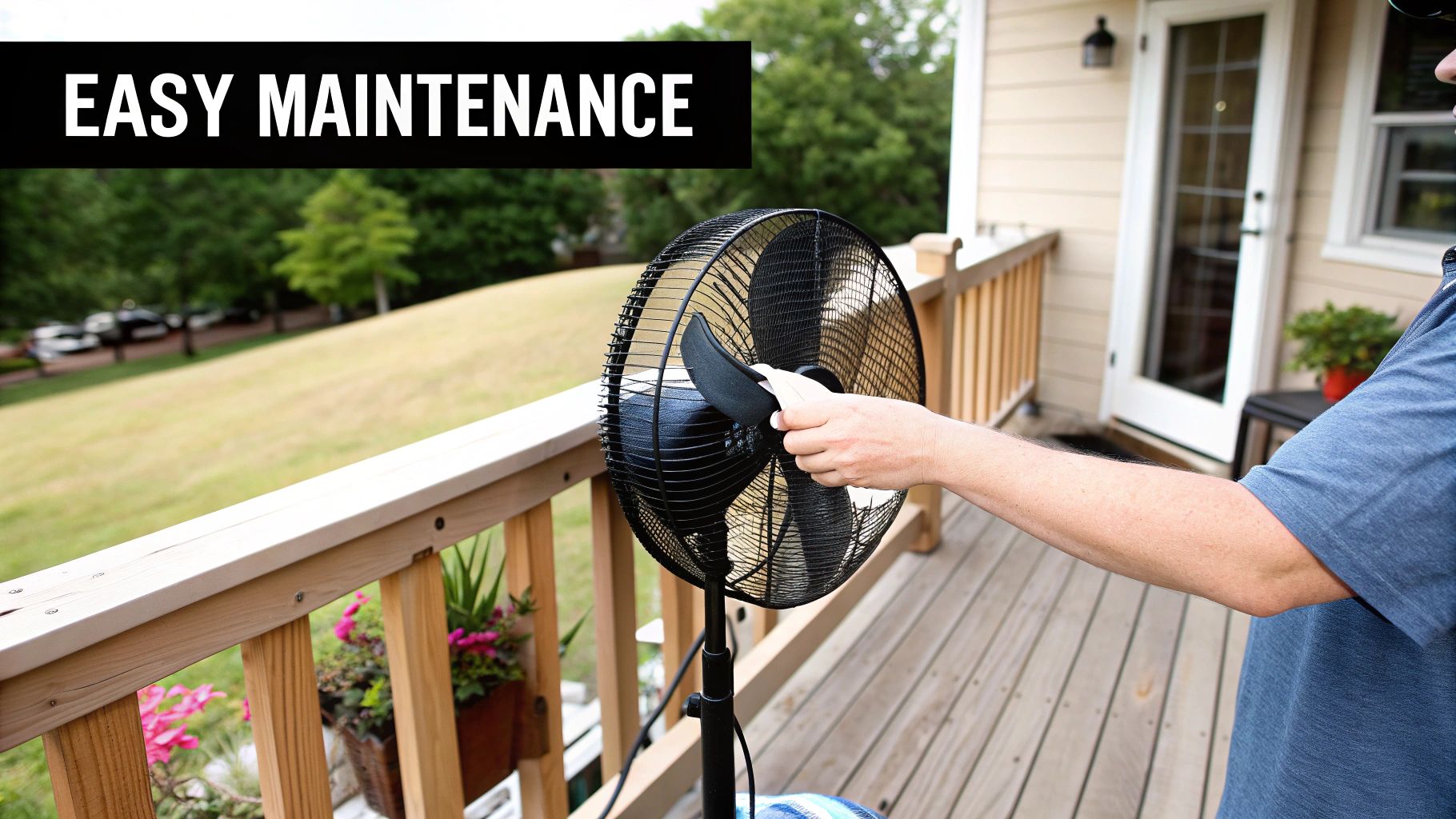
A great outdoor fan is only half the battle. Where you put it matters just as much as its power. The secret is to think less about cooling yourself and more about building an invisible fence that mosquitoes can't cross.
Your fan isn't just for a personal breeze. The goal is to create a wide, steady current of air that acts as a defensive perimeter for your whole patio. You're trying to intercept mosquitoes long before they get a chance to land. When you get this right, your fan becomes a highly effective bug shield.
Find the Wind and Aim Your Airflow
Before you plug it in, check which way the natural breeze is blowing. Always place your fan upwind from your seating area. This way, the fan’s airflow gets a boost from the natural wind, creating a much larger no-fly zone for bugs.
If you put the fan downwind, it fights the natural breeze, creating pockets of still air where mosquitoes can easily slip through.
Once your fan is upwind, aim it so the airflow sweeps across the front of your guests, not directly at their faces. Think of it as creating a wall of wind between your seating area and the yard. It's also smart to aim the fan a bit lower, since mosquitoes often target ankles and legs.
The biggest mistake is pointing the fan right at yourself. For mosquito control, it’s far better to create a cross-breeze that covers the whole area, protecting everyone inside it.
This technique also whisks away the CO2 you exhale, making you effectively invisible to any mosquitoes buzzing nearby.
Master Your Space with Smart Layouts
No two patios are the same, so your fan setup may need some tweaking. Using the oscillation feature is a great way to get broader coverage and eliminate calm spots. If you have a large or odd-shaped deck, using two fans is more effective than one massive one.
Here’s how to handle common scenarios:
- Rectangular Deck: Place one fan in an upwind corner and angle it to blow down the length of the deck. For a long deck, add a second fan at the opposite end to create overlapping airflow.
- Circular Patio: Place your fan just outside the ring of chairs. Set it to oscillate so the breeze sweeps through the middle of the group.
- Covered Porch: A wall-mounted fan is perfect here. Mount it high in a corner and point it downward for a circulating breeze that covers the entire porch.
By thinking strategically about placement, you can turn any outdoor spot into a comfortable, bite-free haven.
Give Your Fan Some Backup: A Layered Mosquito Defense
A strong fan is a great start, but it's even more effective as part of a team. Think of your fan as the MVP of a layered defense. When you combine its powerful breeze with a few other simple tactics, you can create a truly bite-free zone.
First, target mosquitoes at their source. They need water to breed, and a bottle cap is all it takes. Patrol your yard and dump out any standing water in flowerpots, birdbaths, toys, and clogged gutters.
The secret to reclaiming your space is a multi-layered defense. Your fan offers immediate protection, but eliminating breeding grounds and adding natural repellents delivers lasting relief.
Mix in Natural Scents to Supercharge Your Airflow
With breeding grounds gone, boost your fan by adding natural repellents. Plant things mosquitoes hate around your patio.
- Citronella Grass: A classic for a reason. Its scent helps mask the CO2 you exhale, making you harder for mosquitoes to find.
- Lemongrass: A close cousin to citronella, it contains the same repellent oil and adds a fresh citrus smell.
- Lavender and Marigolds: These flowers look great and release scents that mosquitoes actively avoid.
For an extra punch, place citronella candles or torches just outside the fan's direct path. This allows their scent to mingle with the air instead of being blown away, adding another layer of defense that works with the fan's breeze.
This combined approach is catching on. The global market for outdoor mosquito repellent lights was valued at USD 348 million in 2024 and is expected to hit USD 427 million by 2031. You can read more about these trends in a report from Intel Market Research. By layering your fan with these strategies, you can build a complete system that turns your backyard into a no-fly zone.
Your Top Questions About Outdoor Mosquito Fans, Answered
Still deciding which outdoor fan is right for you? Let's clear up some of the most common questions.
How Much Power Do I Really Need?
For mosquito control, power is measured in CFM (Cubic Feet per Minute). This tells you the volume of air the fan can move.
For a small space like a balcony, a fan rated around 1,000 CFM is usually enough. For a larger deck or a serious mosquito problem, step up to 2,000 CFM or more. That will generate a breeze strong enough to ground any pests.
Does It Work on Other Bugs Besides Mosquitoes?
Yes. A powerful fan works wonders on other annoying flyers, too. Gnats, black flies, and common houseflies are also weak fliers, and a stiff breeze makes it nearly impossible for them to navigate. While it’s best known for stopping mosquitoes, that strong airflow is a great all-around pest deterrent.
Pro tip: A layered defense is always best. Instead of one massive fan, try using a couple of smaller ones. This eliminates pockets of still air where mosquitoes hide and gives you consistent coverage across your entire seating area.
Fan technology is also getting smarter. The latest models have features like mobile app controls, and 17% of new smart models now include app integration. You can see how the market is changing and get a peek at what's next.
One final, crucial tip: don't leave your fan out in a storm unless it's built for it. Look for a UL Wet Rating on the label, which certifies it can handle direct rain without becoming a hazard.


